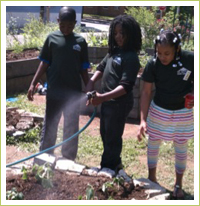
There’s no doubt this year’s weather has been record-setting — from temperatures to rainfall. Parts of the Midwest and South have been drenched with heavy rains, while other parts of the country haven’t seen a drop. No matter where your garden falls on the rainfall spectrum, here’s a refresher course to help keep your plans alive and well this summer.
Watering know-how
Every garden needs water to keep plants thriving and producing those gorgeous blooms and bountiful fruits and vegetables. Remember these tips when gardening this summer:
- Water plants in the early morning or early evening. This allows the water to run down into the soil to the roots of each plant, without losing water to evaporation.
- If your area is getting less than 1 inch of rainfall per week, manually water your garden. Pay special attention to annuals, as perennials are more tolerant of hot and humid conditions.
- How can you tell if your garden needs water? Stick a finger an inch deep into the soil. If it’s dry, it’s time to water. For gardens in the ground, that means watering once or twice a week. If you’re using a raised bed or container, you might need to water every other day.
- Remember to water the roots of a plant and not the foliage. This allows more water to get to the plant and prevents disease caused from moisture on the leaves.
- Apply a layer of mulch to help plants retain moisture and control weeds. Organic matter found in mulches help add nutrients to the soil as well.
- Use the watering technique that works best for your plants. Drip irrigation, soaker hoses and rain barrels can be employed for different areas of your yard.
Rain, rain go away…
While water is important, too much water isn’t always a good thing. Excess water can stunt the growth of plants, cause disease or even kill them. Here are a few ways to help your garden survive soggy weather:
- To prevent disease, ensure plants have good drainage. Incorporating mulch into soil can help with aeration and increase drainage. For containers, make sure all pots have drainage holes to prevent excess water saturating your soil and containers.
- If needed, apply an all-purpose fertilizer to replenish nutrients that are washed away by rain. Follow the instructions on the label of the fertilizer to ensure that it’s correctly applied.
- If a plant becomes diseased, talk with someone at your local garden center about appropriate fungicides. They will know the most common diseases affecting plants in your area and can help recommend treatment.
Making sure your garden has enough water can be tricky. Check back here for more tips, or pose a question to our experts in the Burpee’s Backyard online community.